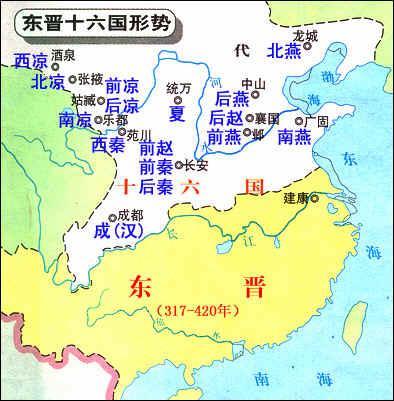The Sixteen States
十六国
The Sixteen Kingdoms (十六国), or less commonly the Sixteen States, were a collection of numerous short-lived sovereignties in China proper and neighboring areas from AD 304 to 439 after the retreat of the Jin Dynasty (265—420) to South China and before the establishment of the Northern Dynasties.
“十六国”是公元304年至439年,也是在晋朝(265——420)撤回中国南方之后、北朝建立之前,中原地区及其周围很多短暂存在的政权的集合。
Originally, the term was first introduced by Cui Hong in the lost historical record, Shiliuguo Chunqiu (the Spring and Autumn Annals of the Sixteen Kingdoms) and restricted to sixteen kingdoms of this era, namely the states of Han Zhao, Later Zhao, Cheng Han, Former Liang, Later Liang, Northern Liang, Western Liang, Southern Liang, Former Yan, Later Yan, Northern Yan, Southern Yan, Former Qin, Later Qin, Western Qin and Xia.
一开始,这个说法在丢失的史料《十六国春秋》中由崔鸿提出,当时仅仅指这个时期的16个国家——汉赵、后赵、成汉、前凉、后凉、北凉、西凉、南凉、前燕、后燕、北燕、南燕、前秦、后秦、西秦和夏国。
The term has been broadened to include all sovereignties from 304 to 439.
后来这个名词所涵盖的意义被扩大为304至439年的所有政权。
These do not all exist through the entire period.
它们并不都存在与一整段时期。
A less used term, the Period of Sixteen Kingdoms represents this turbulent era from 304 to 439.
一个较少使用的说法是,十六国时期代表着从304年到439年间骚乱的时期。
Almost all rulers of the kingdoms were part of the Wu Hu ethnicity and claimed to be the emperors and wangs (kings).
几乎所有的统治者都是五胡的一部分并各自称帝。

The Han Chinese founded the four states: Northern Yan, Western Liang, Former Liang and the state of Wei.
汉人建立了四个国家——北燕、南凉、前凉和魏国。
Six Chinese rulers of the Former Liang remained titularly under the government of the Jin Dynasty.
前凉的六位统治者在晋朝政府的控制下处于名存实亡的状态。
The Northern Wei Dynasty is not counted as one of the Sixteen Kingdoms even though it was founded during the Period.
北魏不被算做十六国之一,尽管它也是在这段时期建立的。












